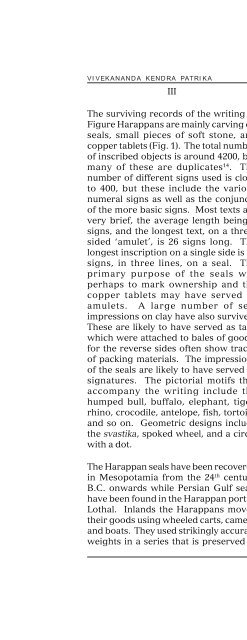Aryan Invasion Theory - Publication - Vivekananda Kendra
Aryan Invasion Theory - Publication - Vivekananda Kendra
Aryan Invasion Theory - Publication - Vivekananda Kendra
You also want an ePaper? Increase the reach of your titles
YUMPU automatically turns print PDFs into web optimized ePapers that Google loves.
VIVEKANANDA KENDRA PATRIKA<br />
III<br />
The surviving records of the writing of<br />
Figure Harappans are mainly carving on<br />
seals, small pieces of soft stone, and<br />
copper tablets (Fig. 1). The total number<br />
of inscribed objects is around 4200, but<br />
many of these are duplicates 14 . The<br />
number of different signs used is close<br />
to 400, but these include the various<br />
numeral signs as well as the conjuncts<br />
of the more basic signs. Most texts are<br />
very brief, the average length being 5<br />
signs, and the longest text, on a threesided<br />
‘amulet’, is 26 signs long. The<br />
longest inscription on a single side is 17<br />
signs, in three lines, on a seal. The<br />
primary purpose of the seals was<br />
perhaps to mark ownership and the<br />
copper tablets may have served as<br />
amulets. A large number of seal<br />
impressions on clay have also survived.<br />
These are likely to have served as tags<br />
which were attached to bales of goods,<br />
for the reverse sides often show traces<br />
of packing materials. The impressions<br />
of the seals are likely to have served as<br />
signatures. The pictorial motifs that<br />
accompany the writing include the<br />
humped bull, buffalo, elephant, tiger,<br />
rhino, crocodile, antelope, fish, tortoise<br />
and so on. Geometric designs include<br />
the svastika, spoked wheel, and a circle<br />
with a dot.<br />
The Harappan seals have been recovered<br />
in Mesopotamia from the 24 th century<br />
B.C. onwards while Persian Gulf seals<br />
have been found in the Harappan port of<br />
Lothal. Inlands the Harappans moved<br />
their goods using wheeled carts, camels,<br />
and boats. They used strikingly accurate<br />
weights in a series that is preserved in<br />
72<br />
ARYAN INVASION THEORY<br />
later Indian weights. The same unique<br />
series is also found on the island of<br />
Bahrein in the Persian Gulf, suggesting<br />
this might have been their colony. Some<br />
of the weights are so tiny that they could<br />
have been used by jewelers to weigh<br />
gold, others are so big that they must have<br />
been hoisted by ropes. Their products<br />
would have included fine pottery wares,<br />
jewelry, copper and bronze vessels, and<br />
woven cotton goods. The variety and<br />
extent of this trade indicates that creditkeeping<br />
and calculations were very<br />
important to the Harappans.<br />
The seals of the historical period also<br />
carry brief texts 15 . Most of the legends<br />
represents the possessive case as in<br />
‘(seal) of X’. There are cases where no<br />
case-ending is used, or where the ending<br />
is nominative as in religious formulae.<br />
The impressions from these seals, like the<br />
earlier seals of the Harappan period,<br />
were used to authenticate records, or to<br />
serve as signatures.<br />
IV<br />
Each letter in Brahmi represent a<br />
consonant combined with a.<br />
Combinations with other vowels are<br />
represented by the use of distinctive<br />
marks which modify the basic sign<br />
(Figure 2). Two consonants together<br />
were expressed by placing the signs for<br />
the two, one on top of another. This<br />
process of combination makes the total<br />
number of distinctive Brahmi signs to be<br />
330 for the 33 consonants alne, without<br />
considering the conjuncts. It is not<br />
surprising, therefore, that Sarasvati has<br />
about 400 signs, and many of these signs

















